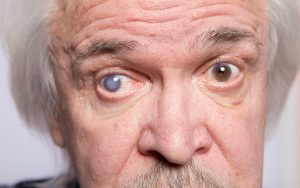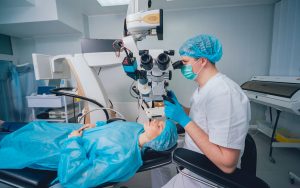5 Practices for People with Myopia

According to the American Optometric Association, nearly 40% of the U.S. population suffers from myopia or nearsightedness. The National Institute of Health lists myopia as one of the most common eye problems in the world. Experts regard myopia as one of the biggest threats to eye health in the 21st century. Myopia is a progressive disease that affects the ability to see distant images or objects. And as it continues to evolve, both the incidence and prevalence of myopia also rise worldwide.
Myopia is similar to other refractive errors in that it causes objects at a certain distance to become blurry. Nothing is more challenging for myopic patients than controlling the effects of myopia. Eye practitioners continue to gather as much knowledge about this progressive disease as possible. And because it evolves so fast, you must also be alert for any changes to your eye. Luckily, nearsightedness is now detectable at earlier ages, and you can prevent it from worsening.
What to Do If You Have Myopia
Do whatever you want but be vigilant to the signs and symptoms of a retinal detachment, including flashing lights, a shower of floating spots, or a curtain over your vision.
Myopia develops in childhood and worsens as your eyes continue to grow.
Children who develop nearsightedness early on are more likely to develop other eye diseases like retinal detachment, glaucoma, and macular degeneration. And because it’s often hereditary, the best way to confirm if you are experiencing myopia is to get a comprehensive eye examination.
The World Health Organization passed a resolution in 2021 to encourage eye practitioners to adhere to standard care for myopia management. The management procedure involves mitigation, measurement, and management of eye disease. The focus is more on public education on myopia and early screening to prevent the condition from worsening.
If you suspect myopia, don’t rush for the traditional correction glasses or contact lenses. Instead, talk to your doctor about your lifestyle-based risk factors, and they will recommend evidence-based treatment to slow down myopia progression.
Parents with myopic children could advise them to modify their lifestyle. The modification could involve the following:
- Spending time outdoors during breaks.
- Less time doing near-work activities.
- Reducing eyestrains.
Such lifestyle adjustments could be effective in reducing myopia genesis and progression.
If you are myopic, you must adopt lifestyle practices that may help reduce the condition’s prevalence. Some might be difficult to adapt, but it will be necessary if you have to improve your vision.
5 Practices for People with Myopia
There is currently no one-size-fits-all home remedy to treat myopia. While many doctors use corrective lenses and surgery to improve vision, there are also natural treatment options that can help you slow down the progression of this fast-evolving eye disease.
1. Increased Time Outdoors
Increased sun time can slow down the progression of myopia and postpone its onset. It may be due to the ultraviolet rays that change the molecular structure of the sclera and cornea. Outdoor light is significantly brighter than the lighting in any room set-up. Several studies have shown that sunlight causes the release of dopamine when it comes into contact with the retina.
Dopamine prevents the eye from growing too long, preventing myopia from worsening. Also, vitamin D smoothens muscle tissues around the eye. Smooth muscles help the eye to focus enough light on the retina and maintain proper eye shape.
2. Protecting the Eyes from the Sun and Close Objects
The sun releases energy in many forms, including the light we see. One of the sun’s emissions, UV rays, is invisible to the eyes and may cause sunburn. UV rays can also harm your eyes and compromise your vision. UV rays can hurt your central vision by damaging the macula. The rays can also damage the cornea and lens from part of the front eye.
Wear sunglasses or a brimmed hat to slow down myopia progression if you spend much time outdoors. Also, refrain from reading too closely. The proper distance for any near vision is at least 16 inches. Avoid sleeping in contacts, and always keep your glasses clean. Do not lean back and read or use your phone or I-pad. When reading, ensure you have proper lighting.
3. Adopt a Healthy Diet
Antioxidant vitamins protect you from numerous age-related eye issues. Eating fresh fruits can help you slow the progression of age-related eye disorders. Fruits such as berries and oranges are rich in vitamin C. Vitamin C can strengthen your immune system, increasing your resistance to eye infections and other diseases. Moreover, fruits rich in vitamin E can also act as antioxidants that preserve your eyesight.
Foods such as deep-water fish maintain lubrication in a child’s eyes and prevent dry eye syndrome. Also, eating deep-water fish can slow down or lower the risk of developing cataracts and macular degeneration.
4. Quit smoking
Smoking can elevate your risk of developing cataracts at an earlier age. The more you smoke, the more harmful free radicals get into your eyes. Free radicals damage the lipids and proteins in your eyes. The resultant protein deposits form on the lens’s eye surface, increasing cataract development.
You can eat fruits rich in antioxidants, but smoking kills them to produce toxins. These toxins result in the formation of cataracts.
5. Avoid Strenuous Activities
If you are nearsighted, avoid wearing glasses to carry out close-up work that doesn’t require glasses. Close-up work could include reading and writing. Wearing glasses will add strain to the ciliary muscle. As a result, their myopia prescription might increase.
Takeaway
You can slow down myopia progression through lifestyle changes. But the best way to control myopia progression is by early detection. So, ensure your kids get regular comprehensive early childhood eye exams. Even if you don’t suspect any sign of vision problems, routine eye exams are necessary for every kid. Parents who have myopia must prioritize regular eye exams for their kids.




